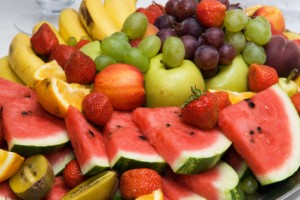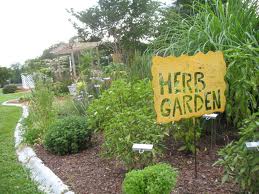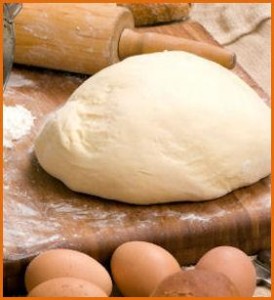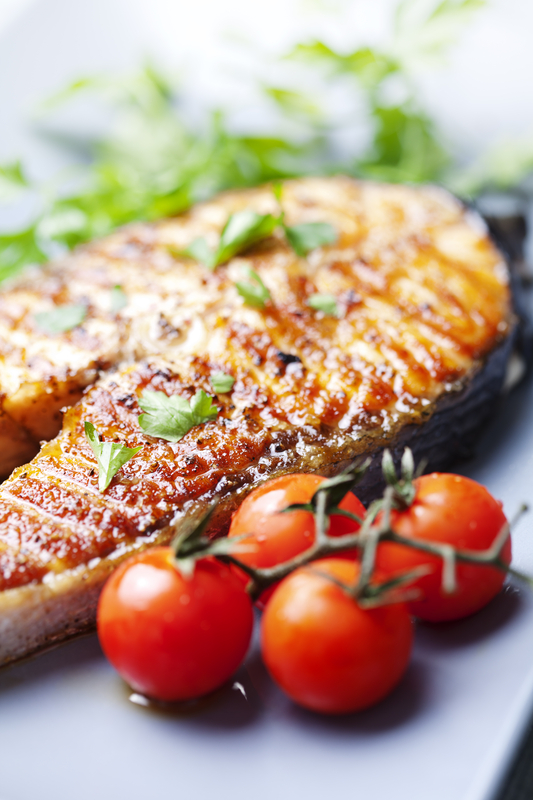by Angela Hinkle | May 28, 2013

Fruit – sweet, refreshing, and good for you!
As the days get warmer, bring on the cool refreshment of fruit. Now is the time to delight in fruit’s tasty, healthy goodness.
Reduce Risk and Protect
A healthy diet that is rich in fruits may reduce risk for heart disease, type 2 diabetes, and obesity, and may protect against certain types of cancers.
Healthy Nutrients
Nature brings most fruit to us low in fat, sodium, and calories, and always with zero cholesterol. Fruits are a great source of many essential nutrients and most of us don’t get enough. These include:
- Dietary fiber – helps to reduce blood cholesterol levels, is important for maintaining proper bowel function, helps reduce constipation, and provides a feeling of fullness without too many calories.
- Potassium – helps to maintain healthy blood pressure.
- Vitamin C – important for repairing all body tissues, healing cuts and wounds, and keeping teeth and gums healthy.
- Folate (folic acid) – helps the body form red blood cells and reduces the risk of neural tube defects during fetal development.
The USDA MyPlate recommends making half your plate fruits and vegetables. http://www.choosemyplate.gov
How Can You and Your Family Eat More Fruit?
- For snacks, wash whatever fruits you have on hand and place them in a big attractive bowl or basket on your table or desk. When you go by, you can grab one and start munching on it.
- Make fruit more fun and interesting by cutting it up and making it into a colorful fruit salad.
- Add fresh, frozen, or canned fruit to a smoothie or shake. Add fruit to drinks like tea and lemonade. Add some fruit to your water for a little kick of taste.
- Make a habit of using fruit as a plate garnish for breakfast, lunch, and dinner.
- Add a variety of fruit chunks to bamboo skewers or craft sticks for kabobs.
- Fruit added to yogurt provides more color, flavor, and nutrition.
- Since dried fruits last a long time, you can store a package in your car, desk, or even your pockets for a quick pick-me-up.
Sweet, refreshing, good for you fruit – now is the time to savor and enjoy.
For more information, contact your UF/IFAS county extension office.
by Kendra Hughson | May 16, 2013

Be adventurous in cooking with herbs!
Many novice cooks fret about what herbs to add to a recipe, when to add them and how much to add. There are no rules when cooking with herbs! The fun of livening up recipes with herbs is in the experimenting. For those who want more guidance, a guide is included indicating which herbs are good with which foods. Use this only as a guide. Experiment by adding a small amount of an herb or combinations of herbs to a dish, then taste. Add more if the flavor doesn’t suit you.
Add the herbs during the last 15-20 minutes of cooking. Certainly this cannot be done for recipes that require the herbs to be mixed in with the batter or dressing, for example. But for stews, vegetables and other recipes, adding herbs at the beginning of the cooking process diminishes the subtle flavor. Fresh herbs pack the most flavor. Gardeners can grow their own herbs and then preserve their harvest by either freezing or drying. Fresh herbs are available at local grocery stores and farmers markets. Dried herbs can be found at any grocery store.
If you don’t have a recipe, start with 1/4 teaspoon and add more as needed to reach your ideal flavor. You don’t want the herbs to overpower the other flavors in the dish. If a recipe calls for dried herbs, you can substitute fresh herbs. Dried herbs are stronger than fresh herbs so you will need to use more of the fresh herbs. If the recipe calls for 1 teaspoon of dried, crushed herbs or 1/4 teaspoon of powdered herbs, use 3 teaspoons (1 tablespoon) of fresh. If a recipe calls for fresh herbs, substitute dried herbs by decreasing the amount by half. When doubling a recipe, do not double the herbs or spices. Increase their amounts by 1 1/2. Remember, it is better to start with less and add more if desired.
Try using fresh herbs to add flavor while cutting back on fat, sugar and salt in recipes. Cooking with herbs also may have additional health benefits. Research is showing herbs have antioxidants which may help prevent cancer and heart disease. So, be adventurous and trying adding more herbs to some of your favorite recipes. Contact your local UF/IFAS Extension office for more information on growing or cooking with herbs.
Guide for Using Herbs:
Mint: Desserts, lamb, peas, fruit salads, sauces
Cilantro: Mexican and Asian cooking, rice, salsa, tomatoes
Sage: Cottage cheese, game meats, pork, rice, poultry, soups (chicken, minestrone, and vegetable), stuffing
Parsley: Salads, vegetables, pastas
Dill: Tomato dishes, yeast breads, eggs, coleslaw, potato salad, fish, beans, Brussels sprouts, cauliflower, cucumber, summer squash
Oregano: Tomato dishes, beef, game meats, veal, spaghetti, clams, soups (bean, minestrone, and tomato), beans, eggplant, and mushrooms
Rosemary: Dumplings, eggs, game meats, lamb, veal, poultry, fish, barbeque sauce, chicken, beef, soups (pea and vegetable), beans, mushrooms, potatoes, cauliflower, turnips
Thyme: Eggs, game meats, lamb, veal, rice, poultry, barbeque sauce, fish, oysters, chowders, soups (onion, tomato, and vegetable), mushrooms, tomatoes
Basil: Tomato products (juice, pasta sauces, pizza sauce, etc.), eggs, game meats, lamb, veal, rice, spaghetti, vinaigrette, soups (minestrone, pea, potato, and vegetable), beans, eggplant
RECIPE: Basil Pesto
- 2 cups fresh basil leaves, removed from stem
- 1/2 cup fresh parsley leaves
- 1/2 cup olive oil
- 2 garlic cloves, peeled
- Salt and freshly ground pepper to taste
- 1/4 cup roasted pine nuts
- 1/4 cup fresh Parmesan or Asiago cheese
In a blender or food processor, puree the basil, parsley, oil, garlic, salt, and pepper. Add the nuts and the cheese and process briefly until the pesto reaches the desired consistency. Makes 2 cups.
by Heidi Copeland | May 15, 2013
 One of the most comforting memories of childhood has to be the smell of homemade yeast bread wafting throughout the house! Baking yeast bread, like many other kitchen traditions is making a comeback. Bread is a wonderful source of carbohydrades, especially if the flour is made from whole grains. (These kernels consist of three parts: the bran, the embryo and the endosperm). Eating breads made with whole grain flour can help you Make Half Your Grains Whole, as the dietary guidelines recommend.
One of the most comforting memories of childhood has to be the smell of homemade yeast bread wafting throughout the house! Baking yeast bread, like many other kitchen traditions is making a comeback. Bread is a wonderful source of carbohydrades, especially if the flour is made from whole grains. (These kernels consist of three parts: the bran, the embryo and the endosperm). Eating breads made with whole grain flour can help you Make Half Your Grains Whole, as the dietary guidelines recommend.
However, the traditional yeast bread making method – proof yeast, knead dough, rise, punch down, rest, form, rise again, and bake….is being debunked!
I’ve been experimenting with many of the recipes in Artisan Bread in Five Minutes a Day and Healthy Bread in Five Minutes a Day mostly to find a simple experience for baking yeast breads with children during 4-H summer camps. However, my experiments have been so successful that I have asked permission from Publicity @St. Martin’s Press to actually publish the master recipe as long as I give credit where credit is due.
There are those out there, myself included, that swear by the discovery of Jeff Hertzberg, M.D., and Zoë Francois that Artisan Bread can indeed be made in just five minutes of “active effort” every day.
The aforementioned authors published their first book in 2007. Currently, they have three best-selling cookbooks on the market, all of which are a very practical guide to producing delicious artisan bread and bread products that require a minimal of basic ingredients: flour, water, yeast and salt. The equipment is nominal too: measuring cups and spoons, a large storage container with a lid, a sturdy mixing tool and of course sheets or pans and an oven to bake your bread in. Of course there are other gadgets but none as necessary as what is listed.
Specifically, the authors choose the French boule (“boule” in French means “ball”) as the basic model for bread making as the shape is easy to form, the taste delicious and quite nutritious.
If you are interested in giving this process a try you can find the recipe in its entirety by clicking here Master Bread Recipe.
by Heidi Copeland | May 9, 2013

Make half your grains whole with homemade whole grain bread.
One of the most comforting memories of childhood has to be the smell of homemade yeast bread wafting throughout the house! Baking yeast bread, like many other kitchen traditions is making a comeback. Bread is a wonderful source of carbohydrades, especially if the flour is made from whole grains. (These kernels consist of three parts: the bran, the embryo and the endosperm). Eating breads made with whole grain flour can help you Make Half Your Grains Whole, as the dietary guidelines recommend.
However, the traditional yeast bread making method – proof yeast, knead dough, rise, punch down, rest, form, rise again, and bake….is being debunked!
I’ve been experimenting with many of the recipes in Artisan Bread in Five Minutes a Day and Healthy Bread in Five Minutes a Day mostly to find a simple experience for baking yeast breads with children during 4-H summer camps. However, my experiments have been so successful that I have asked permission from Publicity @St. Martin’s Press to actually publish the master recipe as long as I give credit where credit is due.
There are those out there, myself included, that swear by the discovery of Jeff Hertzberg, M.D., and Zoë Francois that Artisan Bread can indeed be made in just five minutes of “active effort” every day.
The aforementioned authors published their first book in 2007. Currently, they have three best-selling cookbooks on the market, all of which are a very practical guide to producing delicious artisan bread and bread products that require a minimal of basic ingredients: flour, water, yeast and salt. The equipment is nominal too: measuring cups and spoons, a large storage container with a lid, a sturdy mixing tool and of course sheets or pans and an oven to bake your bread in. Of course there are other gadgets but none as necessary as what is listed.
Specifically, the authors choose the French boule (“boule” in French means “ball”) as the basic model for bread making as the shape is easy to form, the taste delicious and quite nutritious.
If you are interested in giving this process a try you can find the recipe in its entirety by clicking here Master Bread Recipe.pdf
by Amy Mullins, PhD, RDN | Apr 10, 2013
Normal
0
false
false
false
EN-US
X-NONE
X-NONE
/* Style Definitions */
table.MsoNormalTable
{mso-style-name:”Table Normal”;
mso-tstyle-rowband-size:0;
mso-tstyle-colband-size:0;
mso-style-noshow:yes;
mso-style-priority:99;
mso-style-parent:””;
mso-padding-alt:0in 5.4pt 0in 5.4pt;
mso-para-margin-top:0in;
mso-para-margin-right:0in;
mso-para-margin-bottom:10.0pt;
mso-para-margin-left:0in;
line-height:115%;
mso-pagination:widow-orphan;
font-size:11.0pt;
font-family:”Calibri”,”sans-serif”;
mso-ascii-font-family:Calibri;
mso-ascii-theme-font:minor-latin;
mso-hansi-font-family:Calibri;
mso-hansi-theme-font:minor-latin;}

Check your blood pressure regularly to monitor hypertension.
For World Health Day on April 7, the World Health Organization (WHO) chose to highlight high blood pressure as a major public health concern. This chronic disease is responsible for increasing the risk for heart disease and stroke, which are the leading causes of death in the United States. The Centers for Disease Control and Prevention (CDC) estimate that 68 million (1 in 3 adults) in the United States have high blood pressure, also known as hypertension. Because many people show no signs or symptoms of the disease, hypertension is known as a “silent killer” because people often don’t realize they have it.
Having your blood pressure checked regularly is the only way to know if you have a problem. Checking your blood pressure is easy. Your doctor will do this during regular visits, or you can find an automatic blood pressure machine at most pharmacies and major grocery stores. Do you know what your numbers should look like?
Normal
0
false
false
false
EN-US
X-NONE
X-NONE
/* Style Definitions */
table.MsoNormalTable
{mso-style-name:”Table Normal”;
mso-tstyle-rowband-size:0;
mso-tstyle-colband-size:0;
mso-style-noshow:yes;
mso-style-priority:99;
mso-style-parent:””;
mso-padding-alt:0in 5.4pt 0in 5.4pt;
mso-para-margin-top:0in;
mso-para-margin-right:0in;
mso-para-margin-bottom:10.0pt;
mso-para-margin-left:0in;
line-height:115%;
mso-pagination:widow-orphan;
font-size:11.0pt;
font-family:”Calibri”,”sans-serif”;
mso-ascii-font-family:Calibri;
mso-ascii-theme-font:minor-latin;
mso-hansi-font-family:Calibri;
mso-hansi-theme-font:minor-latin;}
|
Blood Pressure Levels
|
|
Normal
|
Systolic: less than 120 mmHg
Diastolic: less than 80 mmHg
|
|
At risk (pre-hypertension)
|
Systolic: 120–139 mmHg
Diastolic: 80–89 mmHg
|
|
High
|
Systolic: 140 mmHg or higher
Diastolic: 90 mmHg or higher
|
Normal
0
false
false
false
EN-US
X-NONE
X-NONE
/* Style Definitions */
table.MsoNormalTable
{mso-style-name:”Table Normal”;
mso-tstyle-rowband-size:0;
mso-tstyle-colband-size:0;
mso-style-noshow:yes;
mso-style-priority:99;
mso-style-parent:””;
mso-padding-alt:0in 5.4pt 0in 5.4pt;
mso-para-margin-top:0in;
mso-para-margin-right:0in;
mso-para-margin-bottom:10.0pt;
mso-para-margin-left:0in;
line-height:115%;
mso-pagination:widow-orphan;
font-size:11.0pt;
font-family:”Calibri”,”sans-serif”;
mso-ascii-font-family:Calibri;
mso-ascii-theme-font:minor-latin;
mso-hansi-font-family:Calibri;
mso-hansi-theme-font:minor-latin;}
What Can You Do?
Many factors can influence your blood pressure, which is defined as the force of blood against your artery walls during circulation. Although hypertension risk can be hereditary and tends to increase as we get older, many other factors can be controlled to reduce your risk of developing the disease. The CDC identifies the use of tobacco or alcohol, as well as being overweight, not getting enough daily physical activity, and excessive dietary sodium as controllable risk-factors.
- Take action to manage your weight by reducing excess calories, fat, and sugar.
- Increase your physical activity everyday, even if it is just walking 30 minutes a day.
- If you smoke, stop now.
- If you consume alcohol, do so in moderation.
- Reduce your sodium intake.
Most sodium in the American diet comes from salt added during food processing. The Dietary Guidelines for Americans (2010) recommends reducing daily sodium intake to no more than 2,300 milligrams (mg) for adults, and to no more than 1,500 mg for persons over the age of 51, African Americans, or those with diabetes or chronic kidney disease. Americans can reduce their sodium consumption in several ways:
- Read the Nutrition Facts label for the sodium content of purchased products and look for lower sodium options.
- Consume more fresh foods and fewer processed foods, such as canned soups, cured meats, condiments, and prepackaged meals.
- Eat more home-prepared meals, where you have more control over added salt. Don’t use seasonings that contain sodium.
- When dining out, ask that salt not be added or choose lower-sodium options, if available.
Don’t wait. Check your blood pressure today and talk to your doctor if you are concerned about your risk for developing chronic hypertension. For more information about lifestyle changes and hypertension, click here. For information on reading labels and ideas on how to cook with less sodium, click here.
Normal
0
false
false
false
EN-US
X-NONE
X-NONE
/* Style Definitions */
table.MsoNormalTable
{mso-style-name:”Table Normal”;
mso-tstyle-rowband-size:0;
mso-tstyle-colband-size:0;
mso-style-noshow:yes;
mso-style-priority:99;
mso-style-parent:””;
mso-padding-alt:0in 5.4pt 0in 5.4pt;
mso-para-margin-top:0in;
mso-para-margin-right:0in;
mso-para-margin-bottom:10.0pt;
mso-para-margin-left:0in;
line-height:115%;
mso-pagination:widow-orphan;
font-size:11.0pt;
font-family:”Calibri”,”sans-serif”;
mso-ascii-font-family:Calibri;
mso-ascii-theme-font:minor-latin;
mso-hansi-font-family:Calibri;
mso-hansi-theme-font:minor-latin;}
References:
Normal
0
false
false
false
EN-US
X-NONE
X-NONE
/* Style Definitions */
table.MsoNormalTable
{mso-style-name:”Table Normal”;
mso-tstyle-rowband-size:0;
mso-tstyle-colband-size:0;
mso-style-noshow:yes;
mso-style-priority:99;
mso-style-parent:””;
mso-padding-alt:0in 5.4pt 0in 5.4pt;
mso-para-margin-top:0in;
mso-para-margin-right:0in;
mso-para-margin-bottom:10.0pt;
mso-para-margin-left:0in;
line-height:115%;
mso-pagination:widow-orphan;
font-size:11.0pt;
font-family:”Calibri”,”sans-serif”;
mso-ascii-font-family:Calibri;
mso-ascii-theme-font:minor-latin;
mso-hansi-font-family:Calibri;
mso-hansi-theme-font:minor-latin;}
The Centers for Disease Control and Prevention, High Blood Pressure. http://www.cdc.gov/bloodpressure/index.htm
U.S. Department of Agriculture and U.S. Department of Health and Human Services. Dietary Guidelines for Americans, 2010. 7th Edition, Washington, DC: U.S. Government Printing Office, December 2010. http://www.dietaryguidelines.gov
Linda B. Bobroff, PhD, RD, LD/N, professor and Extension nutrition specialist; Department of Family, Youth and Community Sciences; , Nutrition for Health and Fitness: Sodium in Your Diet. Institute of Food and Agricultural Sciences; University of Florida, September 2012. http://edis.ifas.ufl.edu/he696
by Ginny Hinton | Mar 21, 2013
 “Fat” is probably one of the most dreaded words in our culture. While our eyes may light up when we smell a juicy steak or see an apple pie, we’re warned to steer clear of those tempting foods before they leave a deposit – right around our waistlines. But wait. Isn’t some fat good for our bodies? Because navigating through the wealth of nutritional information available today can be tough, here’s a primer about the role of fat in good health. Just call it “Fat 101”.
“Fat” is probably one of the most dreaded words in our culture. While our eyes may light up when we smell a juicy steak or see an apple pie, we’re warned to steer clear of those tempting foods before they leave a deposit – right around our waistlines. But wait. Isn’t some fat good for our bodies? Because navigating through the wealth of nutritional information available today can be tough, here’s a primer about the role of fat in good health. Just call it “Fat 101”.
Our bodies need fat in order to work right. Fat gives us energy and helps us absorb vitamins. It protects our internal organs from injury. Without fat, we wouldn’t grow properly or stay healthy. At the same time, at 9 calories per gram compared with about 4 calories per gram in protein or carbohydrates, fat is very high in calories. So, how do we know when to choose fat and when to stay away?
The answer lies in what kind of fat and how much of it we eat. Healthy fats are unsaturated, which means they stay liquid at room temperature. A form of unsaturated fat that is especially heart healthy and can even help lower high triglycerides in our blood is omega-3 fatty acid. “Omega-3s” can be found in fish like salmon, sardines, albacore tuna and rainbow trout. They are also in soybean products, walnuts, flaxseed and canola oil. While omega-3s are no “magic bullet”, they do offer health benefits throughout our lives. Studies have shown that omega-3s can help prevent some types of heart disease, lower triglycerides, reduce chronic inflammation, and promote healthy aging.
Unfortunately, the typical American diet is low in omega-3s. In fact, it’s estimated that only 25% of us consume any omega-3s on most days. That’s partly because the typical American diet involves eating a lot of fast food that contains high amounts of saturated fat and little to no omega-3s. Fortunately, fish oil or flaxseed oil can be purchased as an over-the-counter supplement for those who don’t eat many foods that are high in Omega-3s.
So, the verdict is in. Omega-3s are an important type of fat found mainly in fish and fish oil supplements. These special fatty acids are a necessary part of a diet promoting overall health and fighting heart disease. While all fats are high in calories and should be consumed sparingly, these are the best of the lot and come with exciting benefits that can help us live a longer and healthier life.





